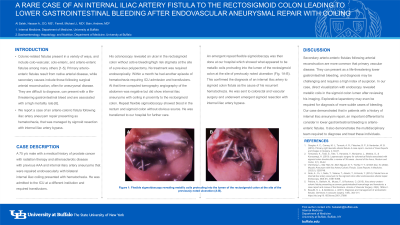Monday Poster Session
Category: GI Bleeding
P2498 - A Rare Case of an Internal Iliac Artery Fistula to the Rectosigmoid Colon Leading to Lower Gastrointestinal Bleeding After Endovascular Aneurysmal Repair With Coiling
Monday, October 28, 2024
10:30 AM - 4:00 PM ET
Location: Exhibit Hall E

Has Audio

Hassan Ali Al Saleh, DO, MS
University at Buffalo
Buffalo, NY
Presenting Author(s)
Hassan Ali Al Saleh, DO, MS1, Michael j. Farrell, MD2, Andrew Bain, MD3
1University at Buffalo, Buffalo, NY; 2University of Buffalo Jacobs School of Medicine, Buffalo, NY; 3Roswell Park Comprehensive Cancer Center, Orchard Park, NY
Introduction: Colonic-related fistulas include colo-vesicular, colo-enteric, and arterio-enteric fistulas among others. Primary arterio-enteric fistulas result from native arterial disease, while secondary causes include those following surgical arterial reconstruction, often for aneurysmal disease. We report a case of an arterio-colonic fistula following iliac artery aneurysm repair presenting as hematochezia, that was managed by sigmoid resection with internal iliac artery bypass.
Case Description/Methods: A 75 y/o male with a medical history of prostate cancer with radiation therapy and atherosclerotic disease with previous AAA and internal iliary artery aneurysms that were repaired endovascularly with bilateral internal iliac coiling presented with hematochezia. He was admitted to the ICU at a different institution and required transfusions. His colonoscopy revealed an ulcer in the rectosigmoid colon without active bleeding/high risk stigmata at the site of a previous polypectomy. No treatment was required endoscopically. Within a month he had another episode of hematochezia requiring ICU admission and transfusions. At that time computed tomography angiography of the abdomen was negative but did show internal iliac aneurysms with coiling in proximity to the rectosigmoid colon. Flexible sigmoidoscopy revealed blood in the rectum and sigmoid colon without obvious source. He was transferred to our institution and an emergent repeat flexible sigmoidoscopy revealed what appeared to be metallic coils protruding into the lumen of the rectosigmoid colon at the site of previously noted ulceration, suggesting an internal iliac artery to sigmoid colon fistula causing his recurrent hematochezia. He was sent to colorectal and vascular surgery and underwent emergent sigmoid resection with internal iliac artery bypass.
Discussion: Secondary arterio-enteric fistulas following arterial reconstruction are more common that primary vascular disease. They can present as a life-threatening lower gastrointestinal bleeding, diagnosis is challenging and requires a high index of suspicion. In our case, direct visualization with endoscopy revealed metallic coils in the sigmoid colon lumen after reviewing his imaging. Our case demonstrated that in patients with a history of internal iliac aneurysm repair, an important differential to consider in lower gastrointestinal bleeding is arterio-enteric fistulas. It also demonstrates the multidisciplinary team required to diagnose and treat these individuals.
Disclosures:
Hassan Ali Al Saleh, DO, MS1, Michael j. Farrell, MD2, Andrew Bain, MD3. P2498 - A Rare Case of an Internal Iliac Artery Fistula to the Rectosigmoid Colon Leading to Lower Gastrointestinal Bleeding After Endovascular Aneurysmal Repair With Coiling, ACG 2024 Annual Scientific Meeting Abstracts. Philadelphia, PA: American College of Gastroenterology.
1University at Buffalo, Buffalo, NY; 2University of Buffalo Jacobs School of Medicine, Buffalo, NY; 3Roswell Park Comprehensive Cancer Center, Orchard Park, NY
Introduction: Colonic-related fistulas include colo-vesicular, colo-enteric, and arterio-enteric fistulas among others. Primary arterio-enteric fistulas result from native arterial disease, while secondary causes include those following surgical arterial reconstruction, often for aneurysmal disease. We report a case of an arterio-colonic fistula following iliac artery aneurysm repair presenting as hematochezia, that was managed by sigmoid resection with internal iliac artery bypass.
Case Description/Methods: A 75 y/o male with a medical history of prostate cancer with radiation therapy and atherosclerotic disease with previous AAA and internal iliary artery aneurysms that were repaired endovascularly with bilateral internal iliac coiling presented with hematochezia. He was admitted to the ICU at a different institution and required transfusions. His colonoscopy revealed an ulcer in the rectosigmoid colon without active bleeding/high risk stigmata at the site of a previous polypectomy. No treatment was required endoscopically. Within a month he had another episode of hematochezia requiring ICU admission and transfusions. At that time computed tomography angiography of the abdomen was negative but did show internal iliac aneurysms with coiling in proximity to the rectosigmoid colon. Flexible sigmoidoscopy revealed blood in the rectum and sigmoid colon without obvious source. He was transferred to our institution and an emergent repeat flexible sigmoidoscopy revealed what appeared to be metallic coils protruding into the lumen of the rectosigmoid colon at the site of previously noted ulceration, suggesting an internal iliac artery to sigmoid colon fistula causing his recurrent hematochezia. He was sent to colorectal and vascular surgery and underwent emergent sigmoid resection with internal iliac artery bypass.
Discussion: Secondary arterio-enteric fistulas following arterial reconstruction are more common that primary vascular disease. They can present as a life-threatening lower gastrointestinal bleeding, diagnosis is challenging and requires a high index of suspicion. In our case, direct visualization with endoscopy revealed metallic coils in the sigmoid colon lumen after reviewing his imaging. Our case demonstrated that in patients with a history of internal iliac aneurysm repair, an important differential to consider in lower gastrointestinal bleeding is arterio-enteric fistulas. It also demonstrates the multidisciplinary team required to diagnose and treat these individuals.
Disclosures:
Hassan Ali Al Saleh indicated no relevant financial relationships.
Michael Farrell indicated no relevant financial relationships.
Andrew Bain indicated no relevant financial relationships.
Hassan Ali Al Saleh, DO, MS1, Michael j. Farrell, MD2, Andrew Bain, MD3. P2498 - A Rare Case of an Internal Iliac Artery Fistula to the Rectosigmoid Colon Leading to Lower Gastrointestinal Bleeding After Endovascular Aneurysmal Repair With Coiling, ACG 2024 Annual Scientific Meeting Abstracts. Philadelphia, PA: American College of Gastroenterology.
